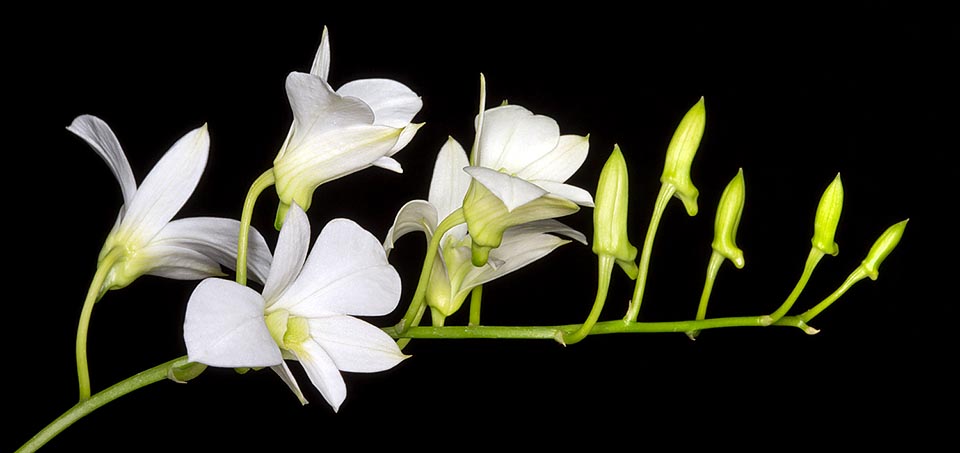Family : Orchidaceae

Text © Pietro Puccio

English translation by Mario Beltramini
The species is native to Australia (Northern Territory and Western Australia), Lesser Sunda Islands, Moluccas and New Guinea where grows as epiphyte in the forests, close to swampy zones, but also at the margins of semi-desertic areas, up to about 300 m of altitude.
The name of the genus is the combination of the Greek terms “δένδρον” (dendron) = tree and “βίος” (bios) = life, with reference to the numerous species of the genus living on the trees; the name of the species is the Latin adjective “affinis” = close, similar, given by the author who described, first, the species, Joseph Decaisne (Decne.), with the name of Onichyum affine, due to a certain resemblance to the Dendrobium mirbelianum Gaudich. (1829).
The Dendrobium affine (Decne.) Steud. (1840) is an epiphytic species with 12-18 cm long cylindrical pseudobulbs with alternate linear-lanceolate leaves with pointed apex, coriaceous, of glossy green colour. Arcuate racemose inflorescence, 30-50 cm long, from the upper nodes also of the pseudobulbs of the previous years without leaves, carrying numerous flowers, of about 3 cm of diameter, opening in succession, of white colour with greenish yellow spot at the base of the labellum; a variant exists with purple red spot. Oblong sepals with pointed apex, the lateral ones, merged at the base of the column, form a sort of spur (mentum), obovate petals and trilobed labellum, with roundish lateral lobes surrounding the column and oblong central lobe with pointed apex.
It reproduces by seed, in vitro, and division, to be done at the vegetative restart, with each section provided of at least 3-4 pseudobulbs.

Dendrobium affine is a North Australian epiphyte, present also in New Guinea, Moluccas and Lesser Sunda Islands with showy 30-50 cm arcuate inflorescences © Giuseppe Mazza
The species is reported in the appendix II of the CITES (species whose trade is internationally ruled).
Synonyms: Onychium affine Decne. (1836); Dendrobium dicuphum F.Muell. (1874); Dendrobium leucolophotum Rchb.f. (1882); Callista affinis (Decne.) Kuntze (1891); Callista dicupha (F.Muell.) Kuntze (1891); Callista leucolophota (Rchb.f.) Kuntze (1891); Dendrobium urvillei Finet (1903); Vappodes affinis (Decne.) M.A.Clem. & D.L.Jones (2002); Vappodes dicupha (F.Muell.) M.A.Clem. & D.L.Jones (2002).
→ For general notions about ORCHIDACEAE please click here.
